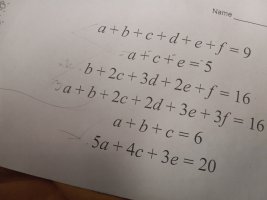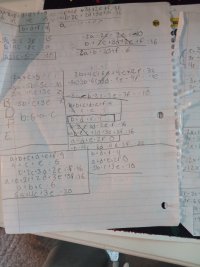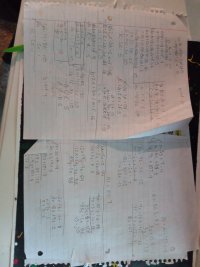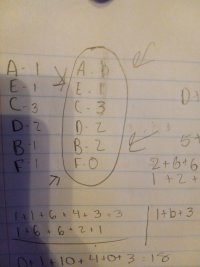Hi I am a freshmen currently taking Algebra 2 and need some help. I am currently going on 4 hours of trying to solve these problems but I just need help. My teacher wants us to find each of the variables values. If someone could please help guide me that would be great
Systems of equations, please help
- Thread starter Smithy
- Start date
mmm4444bot
Super Moderator
- Joined
- Oct 6, 2005
- Messages
- 10,962
Posting Guidelines (Summary)
Welcome to our tutoring boards! :) This page summarizes main points from our posting guidelines. As our name implies, we provide math help (primarily to students with homework). We do not generally post immediate answers or step-by-step solutions. We don't do your homework. We prefer to help...
www.freemathhelp.com
Can you share any work (not four hours' worth), just some samples to show what you've been trying?
EGs:
One equation can be solved for a
a = 5 - c - e
another equation can be solved for b
b = 6 - c - a
Substitution and simplification then yields
b = e + 1
Is that the sort of thing your class has been doing?
?
Dr.Peterson
Elite Member
- Joined
- Nov 12, 2017
- Messages
- 16,808
The usual reason for flailing on a problem like this is not having an orderly plan, but just randomly combining equations.Hi I am a freshmen currently taking Algebra 2 and need some help. I am currently going on 4 hours of trying to solve these problems but I just need help. My teacher wants us to find each of the variables values. If someone could please help guide me that would be great
I would probably try combining pairs of equations to eliminate f first (it could be anything, but f is already missing from three equations), doing that until I had 5 equations with only 5 variables, and then doing the same to eliminate another variable (maybe e), and so on. That way, each step makes progress toward the goal.
When you do that, these can be fun rather than frustrating (as long as the teacher was nice enough to make the solution consist of whole numbers).
Otis
Elite Member
- Joined
- Apr 22, 2015
- Messages
- 4,592
Good observation.f is already missing from three equations
Here's another, for helping to get reduced/simplified equations: Two of the given equations contain multiples of the same variables {a,c,e}.
5a + 4c + 3e can be viewed as
(a + a + a + 2a) + (c + c + c + c) + (e + e + e)
The commutative and associative properties together say that's equivalent to
(a + c + e) + (a + c + e) + (a + c + e) + (2a + c)
and a+c+e is given. Something similar can be done using d+e+f.
?
Thank you all for your help, what I was trying to originally do is eliminate some of the equations. Like you would with solving a 3x3 system of equations problem. I also tried doing substitution, which I eneded with a 2 variable equation. But, I couldn't find anything else after. A bunch of other classmates have had the same issue.
I have also provided my work
I have also provided my work
Attachments
My teacher wants us to find the value of each variable, so I have been trying to eliminate equationsPosting Guidelines (Summary)
Welcome to our tutoring boards! :) This page summarizes main points from our posting guidelines. As our name implies, we provide math help (primarily to students with homework). We do not generally post immediate answers or step-by-step solutions. We don't do your homework. We prefer to help...www.freemathhelp.com
Can you share any work (not four hours' worth), just some samples to show what you've been trying?
EGs:
One equation can be solved for a
a = 5 - c - e
another equation can be solved for b
b = 6 - c - a
Substitution and simplification then yields
b = e + 1
Is that the sort of thing your class has been doing?
?
Otis
Elite Member
- Joined
- Apr 22, 2015
- Messages
- 4,592
Hi Smithy. We're trying to eliminate variables (possibly entire expressions, too) from equations, not eliminate equations themselves. That's what you meant to say, yes? You're trying to manipulate equations until you obtain an equation containing only one variable (to solve). Your work shows that you're trying that.I have been trying to eliminate equations
I won't have time until later this afternoon to look over all your work, and, maybe I won't have to, if you post an update. I've noticed some arithmetic errors, and some of your writing is hard to read. In fact, it may be that you can't read some of it yourself.
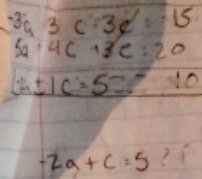
What is that, at the beginning of the third line? It's supposed to be 2a (from 5a-3a), but, for some reason, you wrote -2a in the fourth line. Arithmetic/sign errors are common when solving larger systems by hand, so my advice is (1) slow and steady is best and (2) separate your scratch paper from your "confirmed results" paper. That is, experiment and jot down ideas on scratch paper, but don't transfer results to your confirmed page until you've double-checked them (i.e., did you copy what you meant to, are the signs correct, is the arithmetic verified). Cramming everything onto a sloppy scratch paper invites mistakes. Use lots of scratch paper.
In some cases, we can pick arbitrary but easy-to-work-with values for a beginning equation and use such values to evaluate a result. If we haven't goofed, then the evaluations ought to jive. If they don't, we look for the issue(s). That's way to one way to verify.
Your result of 2a+c=5 matches one of my first results. Good. We can now express c in terms of a or vice versa.
I also see b-e=1, and that matches my work, too. Good. We can now express b in terms of e or vice versa.
At this point, let's revisit the given equation involving a,b,c.
a + b + c = 6
We know that c is 5-2a. Make the substitution
a + b + 5 - 2a = 6
That yields: b - a = 1
What do we have that looks like that?
b - a = 1
b - e = 1
Aha! We see by inspection that a=e.
Then it follows that c=5-2a becomes c=5-2e.
a = e
b = e - 1
c = 5 - 2e
How about that! We know what a+b+c is, so now we can form an equation containing one variable and solve it.
Once you have the value of a variable, you may simplify each result on your confirmed page containing that variable.
Two more hints:
a + b + c = 6
a + b + c + d + e + f = 9
It's obvious what d+e+f equals.
We have two equations containing multiples of d+e+f. For example, we have
a + b + 2c + 2d + 3e + 3f = 16
That's enough stuff to make (a+b+c) and 2(d+e+f) with some leftovers, right?
(a + b + c) + c + 2(d + e + f) + e + f = 16
We have values for those two groupings. Simplify. Try the same with the other equation involving 16.
Can you work toward two equations containing only e's and f's? I think you're almost there.
?
PS: You don't need to write coefficients when they are 1. For example, write c, not 1c.
We use the factor 1 when factoring expressions: c^2+c = c(c+1)
Yes Otis, you are correct. What our teacher taught us is when you have multiple equations you have to multiply another equation (from the one you want to work with) to cancel out a variable. Which leads to canceling out equations. I was trying to make the 6x6 set into a 2x2. That is where I got negatives and what not.Correct me if I am incorrect, but that was my plan to solve. Also apologies for the bad handwriting ?
Last edited:
Otis
Elite Member
- Joined
- Apr 22, 2015
- Messages
- 4,592
Hi Smithy. That specific instruction sounds perfectly reasonable. Perhaps, you're in a class that's preparing for the next step in that direction: Gaussian Elimination (which is a precursor to learning a streamlined process in Linear Algebra using matrix arithmetic).What our teacher taught us is when you have multiple equations you have to [use the Elimination Method] to [eliminate variables].
If elimination is what you "have" to do, then that's the type of exercise instruction that we ask members to include in their first post. We need to start over because that method doesn't use the type of preliminary "shortcuts" that I've taken to initially reduce the system; my plan was to wait until I had a 3x3 or 2x2 system to use elimination.
Side Note: Elimination is what Dr. Peterson had actually suggested, starting with the goal of eliminating variable f. After some analysis of my equation results page, thinking about the given totals on the right-hand sides, I think f is a good place to start -- f seems to act as though it might not be doing anything, heh.
I'm checking your sideways image, to look for any attempts at eliminating f. I'll be back shortly.
Your plan is correct. The Elimination Methods reduces 6x6 to 5x5 to 4x4 and so on, step by step. What is incorrect is your claim that -2a came from the method instead of an arithmetic mistake.trying to make the 6x6 set into a 2x2. That is where I got negatives … Correct me if I am incorrect, but that was my plan
?
Oh no no no, I am sorry Otis we are allowed to use other methods but that is the one my teacher taught. That is another reason why I went to this website because I knew that other people did it other ways. I was interested if people did different methods. Sorry for the misunderstanding
Otis
Elite Member
- Joined
- Apr 22, 2015
- Messages
- 4,592
Very well. What we're doing then is a combination of substitution methods and the elimination method. Glad that's allowed because my attempts at strict elimination started reversing some eliminations. I could've gone the Gaussian route, but I was suspecting several extra steps. Judicial substitutions as we go help to reduce the elimination work.
I looked over your paper on this exercise and the other page, and it appears that you have a good grasp of the elimination concept. The issue I see is too many arithmetic mistakes. Don't rush. Double-check lines, right after you've written them on paper. Confirm the arithmetic. Otherwise, time is spent manipulating equations containing errors, and those errors can spread like wildfire. With more experience, you'll start to see strategies that inform your path, suggesting potential next steps.
If you hit another roadblock, then please show what happened. Don't forget to check your final answer, using the given equations. Cheers
?
I looked over your paper on this exercise and the other page, and it appears that you have a good grasp of the elimination concept. The issue I see is too many arithmetic mistakes. Don't rush. Double-check lines, right after you've written them on paper. Confirm the arithmetic. Otherwise, time is spent manipulating equations containing errors, and those errors can spread like wildfire. With more experience, you'll start to see strategies that inform your path, suggesting potential next steps.
If you hit another roadblock, then please show what happened. Don't forget to check your final answer, using the given equations. Cheers
?
I believe I have an answer, I also realize my mistake which could have saved me hours of work. Thank you so much for all your help, this problem had been soooo stressful for me. I have really bad OCD and this question has been bugging me. Once I got it I almost started crying. Once I got my answers I plugged them back in and it made all equations accurate! I also used the method of using two different sheets for confirmed and experiment and it really helped. I plan on using this all through all classes. THANK YOU SO VERY MUCH!!!!
Attachments
Otis
Elite Member
- Joined
- Apr 22, 2015
- Messages
- 4,592
You fell in the water a few times, Smithy, but you've come out dry! Good job, and good attitude for sticking with it. Like I've said, with sufficient practice you'll begin to see shortcuts, and organizing work is always a good idea. It helps with linear thinking. It reduces both errors and the time spent hunting for 'em. See you next time. PS: Don't struggle for hours on a single exercise before asking for help.
?
?
I am happy that you succeeded. In fact, it is very easy to make errors when solving large systems of linear simultaneous equations. That is why having a consistent method is so important. I also advise checking each elimination or substitution before proceeding. It is very frustrating to find you have made an error at the end and then looking for errors in multiple steps.
Dr.Peterson
Elite Member
- Joined
- Nov 12, 2017
- Messages
- 16,808

